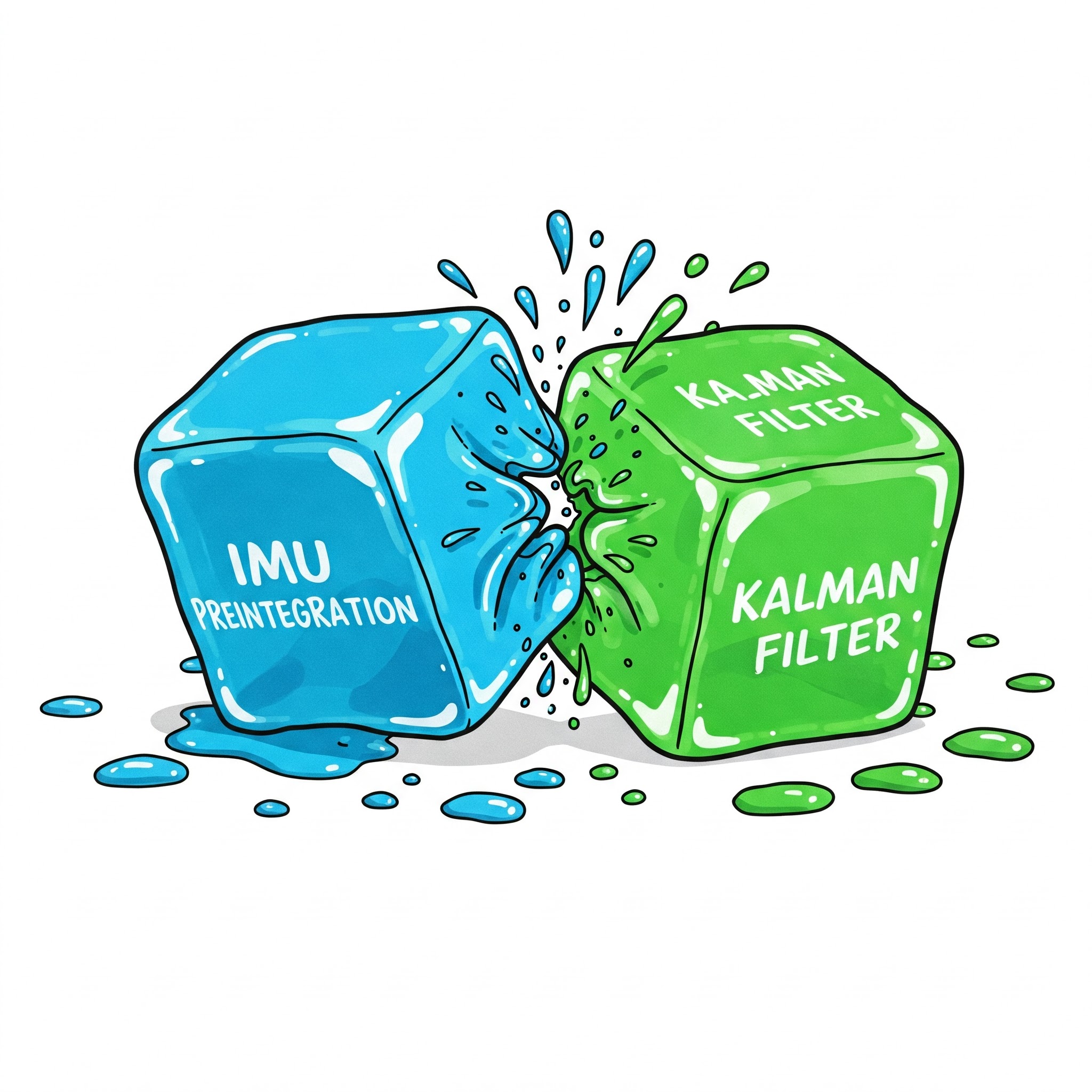
In Kalman-filter-based visual-inertial odometry (VIO) system, inertial measurement unit (IMU), providing acceleration and angular velocity, is essential for state prediction and covariance propagation. However, processing each high-frequency IMU measurement for state update is computationally demanding, and it’s not necessary in most of applications.
To reduce computational load, IMU preintegration1 is applied, which integrates raw IMU data over a time interval to produce a pre-processed high-level measurement. With this technology, only a single filter prediction step is required, instead of implementing filter computation for each raw IMU data.
In this article, I will show the state update and covariance propagation formulas for a Kalman filter using IMU preintegration measurements.
Preliminaries
Consider a Kalman filter estimating following parameters: \(X_k = [ ^{w}p_{b_k}, ^{w}v_{b_k}, ^{w}q_{b_k}, ba_k, bg_k ]\), where \(^{w}p_{b_k}, ^{w}v_{b_k}, ^{w}q_{b_k}\) are position, velocity and attitude of the body frame {b} in the global frame {w} at time step k. \(ba_k\) and \(bg_k\) are accelerometer and gyroscope biases at time step k, respectively.
Given the inertial measurement \(u_k = [ \omega_{m_k}, \alpha_{m_k}]\), where \(\omega_{m_k}\) and \(\alpha_{m_k}\) are measured acceleration and angular velocity at time step k, the state prediction step in the Kalman filter can be expressed as:
\[X_{k+1} = f(X_k, u_k),\]By decomposing the state into an estimated component and an error component, the state can be expressed as \(X_k = \hat{X}_k + \delta{X_k}\). Similarly, the measurement can be expressed as \(u_k = u_k + w_k\), where \(w_k\) is white Gaussian noise affecting the measurement.
The filter’s state prediction step can then be rewritten as:
\[\hat{X}_{k+1} + \delta{X_{k+1}} = f(\hat{X}_k + \delta{X_k} , u_k + w_k).\]After applying first-order linear approximation, the error state propogation formula can be achieved as:
\[\hat{X}_{k+1} + \delta{X_{k+1}} = f(\hat{X}_k , u_k) + F \delta{X_k} + G w_k,\] \[\delta{X_{k+1}} = F \delta{X_k} + G w_k,\]where \(F\) and \(G\) are jacobians of the state transformation function \(f(\cdot)\) with respect to the state \(X_k\) and the measurement \(u_k\), respectively.
State prediction using IMU preintegration
Utilizing IMU preintegration, a batch of raw IMU data are integrated to produce three processed measurements \(u_k = [P_{ij}, V_{ij}, q_{ij}]\) with white Gaussian noise \(w = [w_p, w_v, w_q]\). More detailed derivations can refer to the paper1. The state update from time step \(i\) to time step \(j\) using IMU preintegration is given by:
\[^{w}P_{b_j} = {^{w}P_{b_i}} + {^{w}V_{b_i}} \delta{t} - 0.5 {^{w}g} {\delta{t}}^2 + {^{w}q_{b_i} P_{ij}},\] \[^{w}V_{b_j} = {^{w}V_{b_i}} - {^{w}g} \delta{t} + {^{w}q_{b_i} V_{ij}},\] \[^{w}q_{b_j} = {^{w}q_{b_i}} q_{ij},\] \[ba_j = ba_i,\] \[bg_j = bg_i,\]where \(^{w}g\) is the gravity in the global frame.
Covariance propagation
The jacobians of the state transformation function with respect to the state and the measurement can be expressed as:
\[F = \begin{bmatrix} I & \delta{t} I & -^{w}q_{b_i} {P_{ij}}^\wedge & {^{w}q_{b_i}} \frac{\partial P_{ij}}{\partial ba_i} & {^{w}q_{b_i}} \frac{\partial P_{ij}}{\partial bg_i} \\ 0 & I & -^{w}q_{b_i} {V_{ij}}^\wedge & {^{w}q_{b_i}} \frac{\partial V_{ij}}{\partial ba_i} & {^{w}q_{b_i}} \frac{\partial V_{ij}}{\partial bg_i} \\ 0 & 0 & {q_{ij}}^T & 0 & \frac{\partial q_{ij}}{\partial bg_i} \\ 0 & 0 & 0 & I & 0 \\ 0 & 0 & 0 & 0 & I \end{bmatrix},\] \[G = \begin{bmatrix} {^{w}q_{b_i}} & 0 & 0 & 0 & 0 \\ 0 & {^{w}q_{b_i}} & 0 & 0 & 0 \\ 0 & 0 & I & 0 & 0 \\ 0 & 0 & 0 & I & 0 \\ 0 & 0 & 0 & 0 & I \end{bmatrix}.\]Covariance propagation can be expressed as:
\[P_j = F P_i F^T + G Q_i G^T,\]where \(P\) is the state covariance and \(Q\) is the measurement noise covariance. \(Q\) includes IMU preintegration noise and bias Random Walk noise, and takes the form as:
\[Q_i = \begin{bmatrix} {\sigma_{p_{ij}}}^2 & 0 & 0 & 0 & 0 \\ 0 & {\sigma_{v_{ij}}}^2 & 0 & 0 & 0 \\ 0 & 0 & {\sigma_{q_{ij}}}^2 & 0 & 0 \\ 0 & 0 & 0 & {\sigma_{ba}}^2 & 0 \\ 0 & 0 & 0 & 0 & {\sigma_{bg}}^2 \end{bmatrix}.\]List of jacobian derivatives
Detailed formulas of IMU preintegration derivative with respect to IMU biases can refer to the supplementary material of the paper1.
Position derivative with respect to states
\(\frac{\partial ^{w}P_{b_j}}{\partial ^{w}P_{b_i}} = I\),
\(\frac{\partial ^{w}P_{b_j}}{\partial ^{w}V_{b_i}} = \delta{t} I\),
\(\frac{\partial ^{w}P_{b_j}}{\partial ^{w}q_{b_i}} = -^{w}q_{b_i} {P_{ij}}^\wedge\),
\(\frac{\partial ^{w}P_{b_j}}{\partial ba_i} = \frac{\partial ^{w}P_{b_j}}{\partial P_{ij}} \frac{\partial P_{ij}}{\partial ba_i} = {^{w}q_{b_i}} \frac{\partial P_{ij}}{\partial ba_i}\),
\(\frac{\partial ^{w}P_{b_j}}{\partial bg_i} = \frac{\partial ^{w}P_{b_j}}{\partial P_{ij}} \frac{\partial P_{ij}}{\partial bg_i} = {^{w}q_{b_i}} \frac{\partial P_{ij}}{\partial bg_i}\),
Position derivative with respect to measurements
\(\frac{\partial ^{w}P_{b_j}}{\partial P_{ij}} = {^{w}q_{b_i}}\).
Linear velocity derivative with respect to states
\(\frac{\partial ^{w}V_{b_j}}{\partial ^{w}P_{b_i}} = 0\),
\(\frac{\partial ^{w}V_{b_j}}{\partial ^{w}V_{b_i}} = I\),
\(\frac{\partial ^{w}V_{b_j}}{\partial ^{w}q_{b_i}} = -^{w}q_{b_i} {V_{ij}}^\wedge\),
\(\frac{\partial ^{w}V_{b_j}}{\partial ba_i} = \frac{\partial ^{w}V_{b_j}}{\partial V_{ij}} \frac{\partial V_{ij}}{\partial ba_i} = {^{w}q_{b_i}} \frac{\partial V_{ij}}{\partial ba_i}\),
\(\frac{\partial ^{w}V_{b_j}}{\partial bg_i} = \frac{\partial ^{w}V_{b_j}}{\partial V_{ij}} \frac{\partial V_{ij}}{\partial bg_i} = {^{w}q_{b_i}} \frac{\partial V_{ij}}{\partial bg_i}\),
Linear velocity derivative with respect to measurements
\(\frac{\partial ^{w}V_{b_j}}{\partial V_{ij}} = {^{w}q_{b_i}}\).
Attitude derivative with respect to states
\(\frac{\partial ^{w}q_{b_{j}}}{\partial ^{w}P_{b_i}} = 0\),
\(\frac{\partial ^{w}q_{b_{j}}}{\partial ^{w}V_{b_i}} = 0\),
\(\frac{\partial ^{w}q_{b_{j}}}{\partial ^{w}q_{b_{i}}} = {q_{ij}}^T\),
\(\frac{\partial ^{w}q_{b_j}}{\partial ba_i} = 0\),
\(\frac{\partial ^{w}q_{b_j}}{\partial bg_i} = \frac{\partial ^{w}q_{b_{j}}}{\partial q_{ij}} \frac{\partial q_{ij}}{\partial bg_i} = \frac{\partial q_{ij}}{\partial bg_i}\),
Attitude derivative with respect to measurements
\(\frac{\partial ^{w}q_{b_j}}{\partial q_{ij}} = I\).
Accelerometer bias derivative with respect to states
\(\frac{\partial ba_j}{\partial ba_i} = I\).
Gyroscope bias derivative with respect to states
\(\frac{\partial bg_j}{\partial bg_i} = I\).